|
|
Uniforms
The following is a very general
guide to uniforms worn for various purposes by the Canadian Militia/Canadian Army/Canadian
Armed Forces from 1900 to 1999. Various garments were worn for various purposes with
differing descriptions - i.e. the Service Dress Jacket, the Battle Dress Blouse,
the Combat Shirt. Some definitions are in order.
Parade and Walking Out
- this refers to the uniform generally worn for parades or walking out dress (i.e. leave or
"going out on the town.") Not included in the discussion here are
Ceremonial Dress, Patrol Dress, or Mess Dress. These were never issued to a
majority of Canadian soldiers, be it peacetime or war, and in fact the latter two
categories were private purchase only.
Field - the
uniform intended to be worn for field employment
Work - the
uniform intended to be worn while in garrison and engaged in office work, classes,
maintenance duties, etc.
Summer -
special purpose summer uniforms intended for general purpose wear, including any of the
above three categories
Bear in mind that there were
also many patterns of overalls, coveralls, AFV suits, and tailor-purpose garments for
tradesmen and specialists like tank crews, snipers, motorcyclists, etc. This gear
properly falls under a different category and will be discussed elsewhere. The
following garments were general issue.
| Period |
Parade
&
Walking Out |
Field |
Work |
Summer |
| 1903 |
Service Dress |
Service Dress |
Service Dress |
Khaki Drill |
| 1914-1918 |
Service Dress |
Service Dress |
Service Dress |
Khaki Drill |
| 1918-1939 |
Service Dress |
Service Dress |
Service Dress |
Khaki Drill |
| 1939-1945 |
Service Dress
or Battle Dress
(winter)
Battle Dress or Khaki Drill (summer) |
Battle Dress |
Battle Dress |
Khaki Drill |
| 1946-1967 |
Battle Dress (winter)
Tropical Worsted (summer) |
Black Coveralls |
Black Coveralls |
Bush Dress |
| 1967-1985 |
CF Green |
Combat shirt |
Work Dress |
Canadian Forces Tropical Uniform
began to be issued in the 1970s. |
| 1985-1999 |
DEU |
Combat shirt |
Garrison Dress |
Canadian Forces Tropical Uniform |
First World War
| Service Dress (Canadian
Pattern) Adopted in 1903, the
Canadian patterned Service Dress Jacket was intended as both a dress and field jacket,
replacing the brightly coloured full dress uniforms previously worn (such as the scarlet
tunics worn by infantry, rifle green worn by Rifle regiments, and dark blue worn by the
Artillery).
|
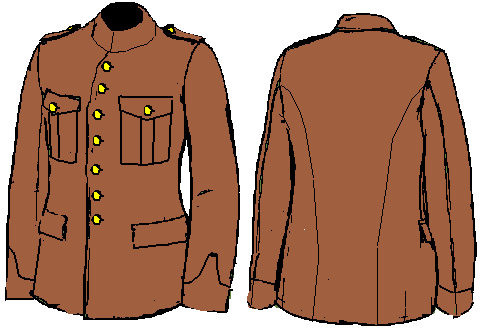 |
|
Canadian Militiamen tended to severely
tailor these jackets, despite orders not to. As an item of field dress, they were
supposed to be cut loose so as to accommodate the wearing of a sweater underneath; many
commanders and men preferred to tailor the tunic to look sharper on parade.
It was this jacket in which Canadian soldiers were
dressed when they went to war in 1914. According to Khaki
by Clive Law, a variant on this jacket also featured "rifle patches" as
found on the standard British Service Dress.
Collar: Stand up
collar secured by hooks and eyes
Shoulder straps: some jackets had coloured shoulder straps, either
detachable or sewn-in (these will be dealt with on a separate page), most had sewn in
straps.
Front Closure: 7 button front
Pockets: Two breast pockets, box pleated, with scalloped
flaps secured by buttons. Two hip pockets with flaps.
Cuffs: Gauntlet style cuffs
Scottish/Highland Pattern: Officially, these jackets were
not supposed to be cutaway to accommodate the sporran, yet throughout the way they were
continually altered in this manner.
|
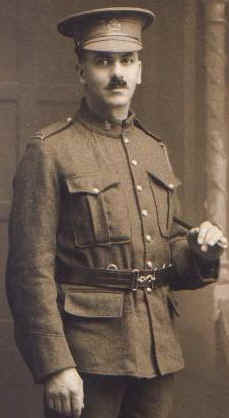 |
Service Dress - First Contingent 1914
Other Ranks of the First Contingent of the
Canadian Expeditionary Force to Europe in 1914 wore the Canadian Service Dress uniform
designed and issued in 1903. It consisted of a close fitting jacket,
trousers, puttees, and ankle boots. The jacket had a stand up collar, and was
fitted with coloured shoulder straps attached, designating the branch of service of the
wearer. Detachable coloured shoulder straps had been in use before the war, although
the colour scheme of straps worn by the First Contingent men was different than the prewar
scheme. The coloured straps were phased out over the first year of the war, being
replaced with plain straps. For those that retained them, the coloured straps remained a
prized sign that the wearer had belonged to the First Contingent.

| Blue |
Infantry |
| Green |
Rifle Regiment |
| Red |
Artillery |
| Signals |
French Grey |
Cavalry
Canadian Army Veterinary Corps |
Yellow |
| Canadian Army Medical Corps |
Maroon |
| Canadian Army Service Corps |
White with blue pipings |
| Engineers |
Blue with yellow pipings, also red oval tab
below shoulder with "CE" in blue |
 |
 |
|
Jacket and photo from the collection of Ed Storey
|
Canadian First
World War shirt courtesy Gary Crocker. |
British
Pattern Uniforms
The inadequacies of Canadian uniforms,
equipment and weapons made themselves felt not long after arrival in England in late 1914.
Everything from wagons to rifles to boots to entrenching tools were inferior to
British made items and were eventually replaced. Many Canadians tailored their British jackets so
that the collar closed in the front, emulating the standup style of collar of the Canadian
jacket. The Canadian made boots were also replaced very soon after arrival in
England with black ankle-high "Ammunition" boots.
Service Dress
(British Pattern)In the field
in France, the CEF found that Canadian pattern jackets (especially those heavily tailored
as mentioned above) were too tightly fitting to be as useful for field service as the
Canadian jacket. Eventually, the CEF began to issue jacket of British pattern.
In addition to the differing features outlined below, the British jacket had
"rifle patches" on the shoulders (an extra layer of wool which resisted the
wearing out of the shoulders due to field chafing from the field equipment).
|
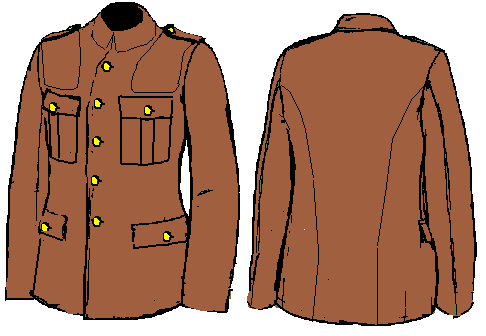 |
|
Collar: Stand and fall collar. This was often
tailored by Canadians, however, by the addition of hooks and eyes that
closed the front of the collar, giving the appearance of a Canadian
stand up collar.
Front Closure: 5 button front
Pockets: Two breast pockets, box pleated,
with straight cut flaps secured by buttons. Two hip pockets with
flaps and buttons.
Cuffs:
Plain cuffs.
Scottish/Highland Pattern: These jackets
were also often seen cut away to accommodate a sporran.
|
  |
|
Above, examples of the British pattern Service Dress Jacket worn
"cut away." At left a soldier of the 92nd Battalion. The collar of
this tunic has been left in British configuration. At right, a tunic with blue
shoulder straps added. Note how the front skirts are rounded off to accommodate the
sporran.

Jacket and photo from the collection of Ed Storey
 |
The Canadian
Militia began the war wearing the Service Dress cap, which was characterized by a stiff crown
and peak, with a leather chinstrap retained by metal buttons.
The steel trench helmet was not
adopted until 1916. At first, they were considered trench stores, but eventually
every soldier got his own. Later in the war, brightly coloured designs, such as
divisional patches or cap badges done in the colours of the divisional patch, were painted
on the helmets. |
Service Dress
(Kitchener Pattern)
During the war, an economy pattern of the
Service Dress Jacket was introduced by the British, which was also issued to Canadians.
(Today referred to as "Kitchener Pattern" after the British General who
raised what was then called "Kitchener's Army." This version differed
from the norm by the deletion of box pleats from the breast pockets, as well as the rifle
pads, in a move to conserve uniform cloth.
 |
 |
Sergeant, at right, decorated with the Military Medal, wears a
"Kitchener pattern" Service Dress Jacket.
Note also the whistle lanyard and other uniform details |
Second World War
Service Dress
At the start of
the Second World War, many different styles of Service Dress were being worn,
and though Battle Dress was officially intended to replace SD, it was worn
until sufficient stocks of Battle Dress could be procured. By
1941, Service Dress was only issued to small numbers of men, mostly musicians.
Some units may have kept small stocks on hand for special parades or to issue
as a walking out uniform. Overseas troops issued with Service
Dress seem to have worn the British pattern (with rifle pads as shown above)
while in Canada, troops began to be issued a special Canadian pattern "Walking
Out Uniform) as shown below.
Summer Dress
The pattern of Khaki
Drill Jacket worn by Canadians between the wars, and in the beginning years of
the Second World War, was very basic in design.
| Collar:
Stand and fall collar.
Front Closure:
5 button front
Pockets: Two breast pockets, box pleated, with straight cut
flaps secured by buttons.
Cuffs:
Plain cuffs.
Scottish/Highland Pattern: These jackets were intended to be
worn with either khaki drill trousers, or shorts, and were probably not
often cutaway to accommodate the kilt. |
 |
Khaki Drill Jacket (Canadian Pattern)
A Canadian pattern of Khaki Drill Jacket was introduced during the war; it
was a departure from earlier uniforms in that it had an open collar design,
allowing the wear of a shirt and tie underneath - a distinction previously
not permitted for Other Ranks. This Canadian Pattern KD was not worn
in Europe; Canadian troops serving in the Mediterranean wore British pattern
KD clothing, and those in Britain and the Continent did not wear Khaki Drill
at all. |
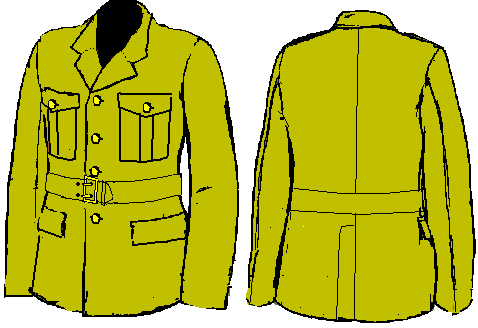 |
|
Collar:
Open collar
Front
Closure: 4 button front. A cloth waist belt was also
worn with this uniform in the absence of other types of belts (i.e. if for a
parade 1937 pattern web belts with bayonets and frogs were worn, the cloth
belt would not be worn.) Some of these jackets had cloth belts permanently
attached. There are also variations such as cloth belt loops, or
eyelets to allow the wearing of belt hooks.
Shoulder straps: Some variants seem to have been made with
shoulder straps, some without.
Pockets: Two breast pockets, box pleated, with scalloped
flaps secured by buttons, two flapped hip pockets.
Cuffs:
Plain cuffs.
Scottish/Highland Pattern: These jackets were intended to be
worn with either khaki drill trousers, or shorts, and were probably not
often cutaway to accommodate the kilt.
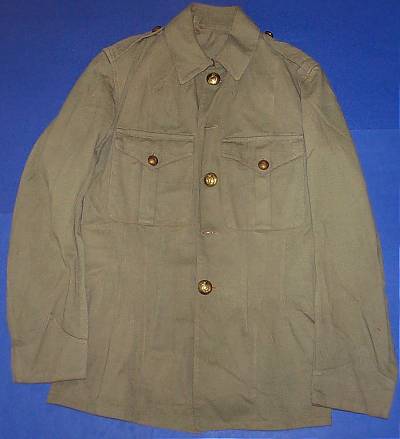 |
 |
Jackets and photos from the collection of Ed Storey |
|
| Walking Out
Uniform
A Canadian
pattern of Service Dress Jacket, often referred to in regulations as a
"Walking Out" uniform, was introduced during the war also. Its style
matched that of the Canadian Pattern Khaki Drill uniform that was introduced
at about the same time. Again, troops in Europe were not issued with
this uniform though there is much evidence of it being used in Canada. |
 |
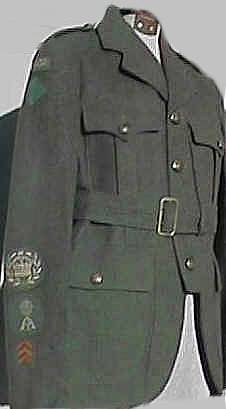 |

|
Walking Out uniform. At left: A jacket cut to accommodate the
sporran. At right: With the buttons and insignia of the Regina
Rifle Regiment, this jacket looks very much like a US Marine Corps
uniform. Note the matching cloth belt, service chevrons, and GS
badge. This jacket has patch pockets on the skirt. Artifact
at right courtesy of Victor Taboika. |
|
|
Battle Dress Blouse
By September
1939, Canada had been in the process of approving the new British Battle
Dress uniform for wear by Canadians. The blouse was a departure from
the uniforms worn by most of the world's armies; cut short at the waist, the
garment was designed with practicality in mind. By 1941, Battle Dress
had been issued to the entire overseas army, and it was to be the uniform of
the army in Canada as well, except when replaced by summer summer dress.
Battle Dress, in its final (1949) form, would be a standard garment of issue
until the 1970s.
 |
 |
| The Battle
Dress Blouse as worn in 1939. |
Battle
Dress worn early in the war showing the characteristics of the early
pattern; khaki slip-on shoulder titles, pleated pockets, and the Field
Service Cap. Drab coloured gloves were worn, usually wool knit but
leather gloves could also be encountered.
(Ontario Archives Photo) |
|
|
Collar: Closed fall collar
Front Closure: 4 or 5 button fly front. A cloth
waist belt was also sewn in at the waist, and secured closed by a buckle
sewn to the lower right waistband.
Pockets: Two breast pockets, box pleated, with scalloped
flaps secured by buttons.
Cuffs: Vented cuffs, secured by hidden buttons.
The wear of
Battle Dress was highly modified during the war; a detailed listing of
Battle Dress variants and regulations regarding the wear of Battle Dress
will be found in the webmaster's upcoming book Dressed to Kill,
to be released by Service Publications. |
|
|
1945 to Unification |
| 1949 Pattern
Battle Dress
After the Second World War, several variations to the Battle Dress blouse
were made, and by the Korean War the 1949 Pattern became the standard.
This pattern remained on inventory, unchanged, until replaced for field
dress with the Combat Uniform. It was retained as a dress uniform,
especially in Reserve units, until replaced by the Canadian Forces uniform
(CF Green) during the late 1960s and early 1970s.
The most visible change to the 1949 Pattern blouse was the addition
of an open collar. Rank insignia for Other Ranks was reduced in size on the
postwar BD, and the coat of arms for Warrant Officer Class I was changed
from the British Royal Arms to the coat of arms of Canada. |
 |
| Tropical Worsted
For dress wear, in place of the Service Dress Jacket, a new Tropical Worsted
jacket (also called a T-dub) was introduced, using lightweight material that
during WW II had been used only in private purchase officers' SD Jackets.
The styling was very close to the Khaki Drill jacket. |
 |
Collar: Open collar
Front Closure: 4 button front. A cloth
waist belt was also worn with this uniform in the absence of other types of
belts (ie if for a parade belt with bayonet and frog was worn, the cloth
belt would not be worn).
Pockets: Two breast pockets, box pleated, with
scalloped flaps secured by buttons, two flapped hip pockets.
Cuffs: Plain cuffs.
Scottish/Highland Pattern: These jackets were
intended to be worn with the kilt as well, and were cut away to accommodate
the sporran. |
Bush Dress
For summer dress, the Khaki Drill uniform was replaced by a green denim
uniform called Bush Dress. Similar to the Khaki Drill jacket,
Bush Dress had several significant differences.
|
 |
| Collar:
Closed collar - almost always worn open; indeed, intended to be worn
with a shirt and tie when used as a parade uniform.
Front Closure:
5 button front. A cloth waist belt was also worn with this uniform
in the absence of other types of belts (i.e. if for a parade belt with
bayonet and frog was worn, the cloth belt would not be worn).
Pockets:
Two breast pockets, box pleated, with scalloped flaps secured by
buttons, two flapped bellows-type hip pockets.
Cuffs:
Vented cuffs secured by a visible button
Scottish/Highland
Pattern: These jackets were intended to be worn with
denim bush trousers and not with the kilt. |
 |
|
|
|
| Coveralls During
the Second World War, khaki overalls had been used by soldiers
in training, both in garrison and in the field, both overtop of wool or denim battledress,
or in lieu of BD.
After the
Second World War coveralls came to be issued in
black and were used extensively for field training in lieu of bush or battle dress.
After unification, they were continued to be issued in rifle green
cloth matching that of the CF work dress, as well as in a neutral
grey coloured cloth. |

Sapper Storey,
Royal Canadian Engineers, in Germany in 1957 wearing the issue coveralls. Sapper
Storey later retired as the Chief Warrant Officer of the Canadian Military Engineering
Branch in 1982. In the background are Universal Carriers, Centurions with
Monotrailers and Jeeps.
Photo courtesy of his son, Warrant Officer Ed Storey, Canadian Military
Engineers |
Combat Dress
During the 1960s,
lightweight nylon-based Combat Dress began to replace the denim Bush Dress; it
remained on inventory into the 21st Century. It was a monochrome olive coloured
combat uniform. A tan variant was created for desert use, and worn on operations
in Somalia in the 1990s by the Airborne Regiment battle group deployed there.
The shirt had angled pockets to accommodate the magazine of the FN C1 assault
rifle; cargo pockets were attached to the outer leg of the trousers. A field
jacket similar in design to the combat shirt was produced in heavy denim, with a
detachable quilted liner.

Work Dress
After
Unification of the three services in 1968, a single uniform for working was
created. Work Dress actually had a variety of components; the standard rifle
green trousers remained common to all uniforms, worn either with parade boots or
combat boots. A linden (light) green shirt or lagoon (sea) green shirt could be
worn with either a rifle green sweater or two-pocket, waist-length "Ike" style
blouse, usually derided as a "bus-driver's jacket."
Canadian Forces
Uniform
The "CF Green"
was worn for ceremonial parades, office duties, and walking out. Similar to the
older "T-Dub", it consisted of a rifle green jacket and trousers, with skirts
also made for female personnel.
De-Unification
The
Conservative government under Brian Mulroney instituted a segregation of the
three services with respect to uniforms in the late 1980s, and a return to
distinctive uniforms. Garrison Dress replaced Work Dress, with a tan shirt and
camouflage jacket becoming the standard, with high-topped smooth leather boots
worn and expected to be highly polished. The CF Greens were replaced by two
uniforms, a Distinctive Environment Uniform (DEU), in dark green for winter, and
tan for summer. Outwardly, the uniforms were similar to the CF Green, though
they were cut differently, lacked shoulder padding, and had epaulettes added,
which brought back the traditional metal shoulder titles into wear throughout
the land forces.
|